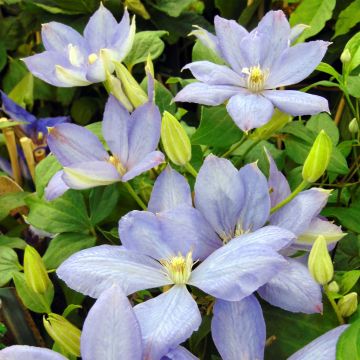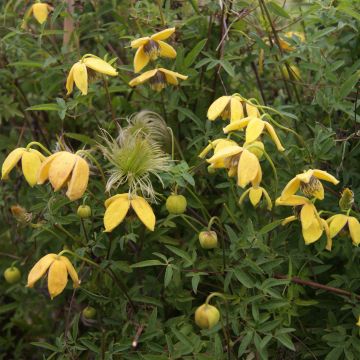

Clematis patens Doctor Ruppel


Clematis patens Doctor Ruppel


Clematis patens Doctor Ruppel


Clematis patens Doctor Ruppel


Clematis patens Doctor Ruppel


Clematis patens Doctor Ruppel


Clematis patens Doctor Ruppel


Clematis patens Doctor Ruppel


Clematis patens Doctor Ruppel


Clematis patens Doctor Ruppel


Clematis patens Doctor Ruppel
View more pictures
Hide images

Thierry P.

September flowering - picture 1 - first flower in the middle of a "Reine des Reinettes" apple tree.
Thierry P. • 84 FR
Clematis patens Doctor Ruppel
Clematis patens Docteur Ruppel
The delivery person distributed without being disrupted by a public holiday, resulting in one less day of transport, so the young plants arrived in excellent condition. A quick refresh and planted! Very satisfied.
Joël , 22/05/2025
Special offer!
Receive a €20 voucher for any order over €90 (excluding delivery costs, credit notes, and plastic-free options)!
1- Add your favorite plants to your cart.
2- Once you have reached €90, confirm your order (you can even choose the delivery date!).
3- As soon as your order is shipped, you will receive an email containing your voucher code, valid for 3 months (90 days).
Your voucher is unique and can only be used once, for any order with a minimum value of €20, excluding delivery costs.
Can be combined with other current offers, non-divisible and non-refundable.
Home or relay delivery (depending on size and destination)
Schedule delivery date,
and select date in basket
This plant carries a 6 months recovery warranty
More information
We guarantee the quality of our plants for a full growing cycle, and will replace at our expense any plant that fails to recover under normal climatic and planting conditions.

Would this plant suit my garden?
Set up your Plantfit profile →
Description
Clematis 'Doctor Ruppel' is a compact climbing plant, suitable for potted cultivation. It boasts abundant and perpetual flowering. Balconies and patios will quickly adopt this perennial with very romantic shades. From the end of spring, large, sometimes semi-double, flowers flood the foliage and bring colour and cheer to the garden. The tepals are bright pink over a central band and edged with pale-pink. They surround a heart bristling with white-cream stamens with brown anthers. This flowering will pause in summer and resume in September to sprinkle floral stars on the trellises and walls that this hardy plant likes to cover.
This cultivar was born in Argentina and bears the name of its breeder. It was introduced to Europe in the early 1970s by Jim Fisk. Belonging to the Ranunculaceae family, this clematis, like most of its cousins, likes light, deep, moist, and fertile soil that is preferably neutral. It appreciates a sunny or partially shaded exposure, with its base always in shade. It is resistant to cold and does not fear frost, even if it is severe. On the other hand, it does not like stagnant moisture, so the substrate must be well-draining and watering should be moderate (if necessary in the first year). It is suitable for potted cultivation if the pot is large enough (minimum 60cm (24in) in diameter).
'Doctor Ruppel' is a reasonably sized climber that can reach 2 to 3m (7 to 10ft) in height. The previous year's stems will bear the spring flowers from May to June. These flowers are sometimes semi-double. They are composed of a minimum of 6 to 9 tepals and reach 15cm (6in) in diameter. The late summer flowering (carried by the current year's branches) will take place in September. The flowers display the same shades that give them a piquant charm. The soft light pink tepals end in a point, often with undulate margins. They are kissed in the centre by a fairly deep pink that enhances the whole. They open completely and reveal a heart of white-cream stamens with darker tips. Subsequently, fruits appear, which will adorn the foliage and remain until winter. The leaves, composed of 3 to 5 leaflets, are deciduous and a beautiful bright green. They are carried by voluble stems that twine around their support.
In a pot, with a trellis to support it, 'Doctor Ruppel' will reward owners of a small balcony and will flower for a long time even in partial shade. Place some spring bulbs at its base and enjoy the show with minimal maintenance. To enhance this picture a little more, Clematis 'Baby Star', as well as the 'pink and white arbour' collection, will keep it company in perfect harmony. Finally, if you have a larger space, this non-invasive clematis can weave its way on a bamboo teepee or a column, bringing verticality to a romantically inspired flower bed.
Report an error about the product description
Clematis patens Doctor Ruppel in pictures




Plant habit
Flowering
Foliage
Botanical data
Clematis
patens
Docteur Ruppel
Ranunculaceae
Cultivar or hybrid
Other Clematis Patens
View all →Planting and care
'Docteur Ruppel' should be planted in spring or autumn at a depth of 5cm (2in), with the root ball positioned diagonally or even horizontally on the ground. The top should be in the sun (or partial shade) and the base in the shade. You can place a flat tile in front of the stump or plant ground cover plants. It prefers relatively moist but not waterlogged, deep, well-worked, well-drained, and fertile soils. Cover the base with a small mound of soil to encourage the emergence of new shoots. After planting, prune the shoots to 30cm (12in) from the base, above a pair of buds. Train them loosely to help the plant cling on its own later on. Maintenance pruning should be done after flowering (in mid-summer) to remove faded flowers and shorten the flowering shoots. This will allow the plant to produce new shoots for a second flowering. More vigorous pruning can be done in spring to cut back certain shoots more severely, but not necessarily every year. Watch out for pests such as aphids and gastropods.
Planting period
Intended location
Care
-
, onOrder confirmed
Reply from on Promesse de fleurs
Similar products
Haven't found what you were looking for?
Hardiness is the lowest winter temperature a plant can endure without suffering serious damage or even dying. However, hardiness is affected by location (a sheltered area, such as a patio), protection (winter cover) and soil type (hardiness is improved by well-drained soil).

Photo Sharing Terms & Conditions
In order to encourage gardeners to interact and share their experiences, Promesse de fleurs offers various media enabling content to be uploaded onto its Site - in particular via the ‘Photo sharing’ module.
The User agrees to refrain from:
- Posting any content that is illegal, prejudicial, insulting, racist, inciteful to hatred, revisionist, contrary to public decency, that infringes on privacy or on the privacy rights of third parties, in particular the publicity rights of persons and goods, intellectual property rights, or the right to privacy.
- Submitting content on behalf of a third party;
- Impersonate the identity of a third party and/or publish any personal information about a third party;
In general, the User undertakes to refrain from any unethical behaviour.
All Content (in particular text, comments, files, images, photos, videos, creative works, etc.), which may be subject to property or intellectual property rights, image or other private rights, shall remain the property of the User, subject to the limited rights granted by the terms of the licence granted by Promesse de fleurs as stated below. Users are at liberty to publish or not to publish such Content on the Site, notably via the ‘Photo Sharing’ facility, and accept that this Content shall be made public and freely accessible, notably on the Internet.
Users further acknowledge, undertake to have ,and guarantee that they hold all necessary rights and permissions to publish such material on the Site, in particular with regard to the legislation in force pertaining to any privacy, property, intellectual property, image, or contractual rights, or rights of any other nature. By publishing such Content on the Site, Users acknowledge accepting full liability as publishers of the Content within the meaning of the law, and grant Promesse de fleurs, free of charge, an inclusive, worldwide licence for the said Content for the entire duration of its publication, including all reproduction, representation, up/downloading, displaying, performing, transmission, and storage rights.
Users also grant permission for their name to be linked to the Content and accept that this link may not always be made available.
By engaging in posting material, Users consent to their Content becoming automatically accessible on the Internet, in particular on other sites and/or blogs and/or web pages of the Promesse de fleurs site, including in particular social pages and the Promesse de fleurs catalogue.
Users may secure the removal of entrusted content free of charge by issuing a simple request via our contact form.
The flowering period indicated on our website applies to countries and regions located in USDA zone 8 (France, the United Kingdom, Ireland, the Netherlands, etc.)
It will vary according to where you live:
- In zones 9 to 10 (Italy, Spain, Greece, etc.), flowering will occur about 2 to 4 weeks earlier.
- In zones 6 to 7 (Germany, Poland, Slovenia, and lower mountainous regions), flowering will be delayed by 2 to 3 weeks.
- In zone 5 (Central Europe, Scandinavia), blooming will be delayed by 3 to 5 weeks.
In temperate climates, pruning of spring-flowering shrubs (forsythia, spireas, etc.) should be done just after flowering.
Pruning of summer-flowering shrubs (Indian Lilac, Perovskia, etc.) can be done in winter or spring.
In cold regions as well as with frost-sensitive plants, avoid pruning too early when severe frosts may still occur.
The planting period indicated on our website applies to countries and regions located in USDA zone 8 (France, United Kingdom, Ireland, Netherlands).
It will vary according to where you live:
- In Mediterranean zones (Marseille, Madrid, Milan, etc.), autumn and winter are the best planting periods.
- In continental zones (Strasbourg, Munich, Vienna, etc.), delay planting by 2 to 3 weeks in spring and bring it forward by 2 to 4 weeks in autumn.
- In mountainous regions (the Alps, Pyrenees, Carpathians, etc.), it is best to plant in late spring (May-June) or late summer (August-September).
The harvesting period indicated on our website applies to countries and regions in USDA zone 8 (France, England, Ireland, the Netherlands).
In colder areas (Scandinavia, Poland, Austria...) fruit and vegetable harvests are likely to be delayed by 3-4 weeks.
In warmer areas (Italy, Spain, Greece, etc.), harvesting will probably take place earlier, depending on weather conditions.
The sowing periods indicated on our website apply to countries and regions within USDA Zone 8 (France, UK, Ireland, Netherlands).
In colder areas (Scandinavia, Poland, Austria...), delay any outdoor sowing by 3-4 weeks, or sow under glass.
In warmer climes (Italy, Spain, Greece, etc.), bring outdoor sowing forward by a few weeks.


















































